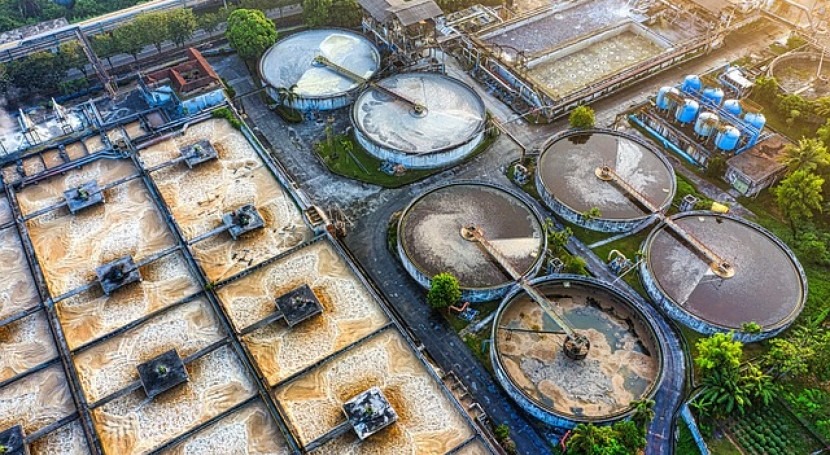Comprehensive Guide to Industrial Waste Water Treatment Processes
Comprehensive Guide to Industrial Waste Water Treatment Processes
Blog Article
Strategic Approaches to Improve Drainage Treatment Efficiency and Reduce Ecological Effect
In the world of waste water treatment, the quest for improved performance and minimized ecological impact is a perpetual challenge that demands critical options. The assimilation of sophisticated treatment modern technologies, energy-efficient processes, source recuperation techniques, enhanced nutrient removal techniques, and wise surveillance and control systems stands for a multifaceted structure for attending to these pushing problems.
Advanced Treatment Technologies
Cutting-edge membrane layer filtration systems have actually reinvented sophisticated wastewater therapy procedures, significantly enhancing the removal of contaminants. These innovative systems function by requiring water through a semi-permeable membrane, efficiently dividing contaminations from the water stream. The membrane layer's microscopic pores catch toxins such as germs, infections, and suspended solids, enabling just cleansed water to pass through. This modern technology has actually proven to be extremely efficient in removing a broad variety of contaminants, consisting of drugs, heavy steels, and natural compounds, which are usually challenging to get rid of via standard therapy methods.
Moreover, membrane layer purification systems offer countless advantages over conventional treatment methods. They require less space, create higher-quality effluent, and are much more resistant to variations in influent water high quality. Furthermore, these systems are highly flexible and can be conveniently integrated right into existing therapy plants or utilized as standalone systems for decentralized applications. As the need for clean water remains to rise, the adoption of sophisticated membrane layer filtration innovations is necessary to make sure reliable and sustainable wastewater therapy methods.
Energy-Efficient Processes
The combination of energy-efficient procedures in wastewater treatment systems is essential for maximizing resource usage and minimizing functional prices. By applying energy-efficient modern technologies, treatment plants can substantially decrease their carbon impact and total ecological influence. One crucial technique to boosting power effectiveness in wastewater therapy is the usage of sophisticated aeration systems, such as great bubble diffusers or surface area aerators, which can enhance oxygen transfer effectiveness and minimize power consumption. Furthermore, incorporating power healing systems, like anaerobic digestion for biogas manufacturing or using excess warmth for thermal processes, can help offset energy demands and promote sustainability.
Additionally, maximizing procedure control and automation through making use of sophisticated sensing units and keeping track of systems can improve general power efficiency by readjusting procedures in real-time based on actual demand and problems. Executing energy audits and routinely keeping track of power performance indications are crucial techniques to determine areas for improvement and track energy-saving campaigns properly. Generally, the fostering of energy-efficient processes in wastewater treatment not only benefits the setting however additionally contributes to long-lasting cost savings and functional sustainability.
Source Healing Methods
With a concentrate on optimizing source application and sustainability in wastewater therapy systems, the application of resource recovery approaches find this arises as a crucial aspect in enhancing functional effectiveness. Source recovery methods in wastewater treatment entail the identification and removal of important sources from the waste stream, consequently turning what was as soon as considered waste right into a useful possession. By visit site executing resource healing techniques such as nutrient removal and recuperation, power generation from organic matter, and the production of multiple-use water, wastewater therapy plants can reduce ecological impact while making the most of efficiency.

Boosted Nutrient Removal Techniques
Carrying out sophisticated nutrient removal methods is necessary for maximizing the efficiency of wastewater therapy systems. One of the essential techniques made use of for boosted nutrient removal is the process of biological nutrient removal (BNR), which includes the removal of nitrogen and phosphorus with organic processes.

Along with BNR, progressed therapy approaches such as membrane layer bioreactors (MBRs) and constructed wetlands can likewise be employed to improve nutrient removal efficiency. MBRs utilize membranes to accomplish high-grade effluent standards by effectively getting rid of nutrients and suspended solids. Built additional resources wetlands simulate all-natural wetland procedures to eliminate nutrients with plant uptake, microbial activity, and sedimentation. By incorporating these sophisticated nutrient elimination methods right into wastewater treatment communities, systems and markets can efficiently lower nutrient air pollution and protect the atmosphere.
Smart Monitoring and Control Systems
Utilizing advanced technology, the combination of clever monitoring and control systems reinvents the operational performance of wastewater therapy centers. These systems integrate sophisticated sensing units and data analytics to continuously keep an eye on crucial criteria such as pH degrees, turbidity, liquified oxygen, and circulation prices in real-time. By accumulating and analyzing this information, operators can obtain valuable insights right into the performance of the treatment processes, allowing proactive adjustments to enhance treatment effectiveness.
Smart monitoring and control systems likewise sustain remote surveillance capabilities, permitting operators to access real-time data and control functions from off-site places. This remote ease of access boosts operational versatility and responsiveness, enabling quick treatments in situation of system breakdowns or fluctuations in influent top quality. The predictive maintenance abilities of these systems aid prevent equipment failures and lessen downtime, ultimately enhancing the general integrity of wastewater treatment procedures.
Conclusion
To conclude, tactical strategies such as advanced therapy technologies, energy-efficient procedures, resource healing strategies, improved nutrient elimination strategies, and smart tracking and control systems play a critical role in boosting wastewater therapy effectiveness and lessening ecological influence. By applying these techniques, wastewater treatment plants can improve their overall performance, reduce energy consumption, recuperate valuable sources, and make sure compliance with ecological regulations. These strategies are essential for sustainable and effective wastewater management methods.
In conclusion, strategic strategies such as sophisticated therapy innovations, energy-efficient procedures, source recovery approaches, improved nutrient removal strategies, and wise surveillance and control systems play a vital function in enhancing wastewater therapy efficiency and minimizing environmental effect.
Report this page